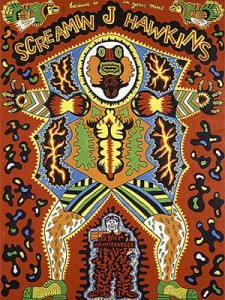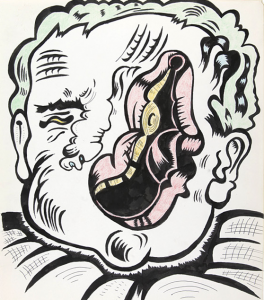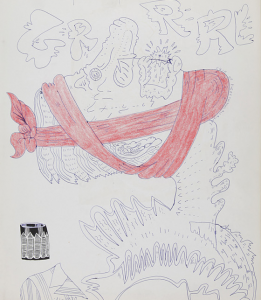Karl Wirsum at Derek Eller
There is some hard to pinpoint quality to Karl Wirsum’s drawings currently on show at Derek Eller. I think it must be in the ballpoint pen palling around with pencil, ink and color pencil on paper. All of the above, it seems sure, palled around too with a healthy (sic) waft of marijuana. The loopy, hippy, hallucinogenic –not to say psychedelic– quality of many of these drawings was of its moment: the 1970’s when that decade was still skidding out of the 1960’s many colored haze. At its worst think Peter Max. In the Wirsum show there are 20-30 pieces of framed work. All dating from the late 1960’s through the 1970’s and all, apparently, tear sheets from a drawing or sketching pad. Here they are retrieved from the unjust oblivion of ‘working drawings,’ and the hippie sub-genre that threatens at times to overwhelm them, by both what we know they might grow up to be in Wirsum’s hands, and by their history of being umbilically attached to the whole Chicago imagist homage to cartooning and sundry “low” culture.
The tone throughout is of the body not yet assembled. Often, almost always, there are exaggerated orifices, dismembered or un-remembered body parts. There are distended, distressed limbs and pustulent stretches of skin. Tumors, if not actual bodily organs, seem to sprout everywhere. Frequently the body is offered as an accumulation of organic looping, intestinal patterns. As if the pen having taken off on its own represents the edges of the body as a lacerated filigree where there is no frontier between the drawn body and the world of the paper and pencil marks. The work deliberately, one assumes, treads the shadow of psychotic musings upon the body, the page, and the space between the two.
Many of the drawings have hand written notations. Hints of changes to be made when executed as, presumably, larger less sketchy paintings on canvas. One such drawing is “study for the painting Screamin’ j Hawkins 1968”. The painting in question became cover art for the well know Hawkins album, Feast of the Mau Mau. Screamin’ J Hawkins was of course the raw R& B singer who put a spell upon the world by bringing vaudeville, histrionics along to hijack pop music. It should have been a marriage made in heaven for the hairy who painter and the over-wardrobed trickster.
And the honeymoon is there in the drawing. A face teetering dangerously close to a minstrel show ‘blackface’ anchors a body of internal organs on the outside with legs akimbo, coming into its own as a chest thumping King Kong. And, scream all you want, this is where Wirsum and the other imagists are at their best; interloping, Like Hawkins, in one world to culturally refinance it with musings from another. Golub and Spiro brought politics; Westerman brought his hauntings of military life to be rethreaded as a more bearably but still wounded narrative. And Ray Yoshida mentored them along with his literal bodies in pieces.
It was Otto Dix and George Grosz in rendering the beggars and match sellers seen on every 1920’s Berlin street corner that brought the ghastly injuries of WW1 into the cannon of modernism. Deliberately scratching against the grain of any cannon as he does, there was, nonetheless, for Wirsum the nightly newscast war from Vietnam. That war’s photogenic atrocities can hardly have not seeped into the non-canonical imagist bank. And so it is that, like a merry prankster hail to the viewer, “Cutting my eye tooth” (1970), thrusts an implausibly vivid, and raucously comic grotesque our way. And if Wirsum’s drawing echoes awfully with etchings from Dix’s Der Krieg series. that echo resounds, like the clacking of so many falling dominoes, with Ignatz and Krazy, and on to itchy and scratchy.
Meanwhile –and his titles can be labyrinthine traps to relish– “Study for the painting gargoyle, gargle” (1970) contorts the body through exoskeletal jags, glottal spasms and (I think?) sewn together lips barely restrained by a bloodied bandage.
Grrr! One might say. The wound is the Chicago imagist frontier. A second city gag. A sly riposte, within the general and less sly riposte that imagist work was, to New York art suprematism of the time. Aghast at the reductive dead end of modernism, aka minimalism, Wirsum et al embraced a more or less growl, more or less scream, visually encoded as a horror vacuii that pinned every corner of the canvas down as busily signifying something, anything!
In Wirsum’s finished paintings what are here ragged edged and rough renderings sometimes become flatter, more graphic –arguably– less troublesome. The distended, tumorous breasts, noses, ears etc of these sketches dissolve, in the finished paintings into more benign areas of color, blocks of barely signifying paint. That is why this Derek Eller show of previously undervalued tear sheets, blatant commerce driven strategy though it doubtless is, is of value to the viewer. It rescues the troublesomeness of Wirsum’s work for us. And it is the troublesomeness that pleases. The pleasure lode is found there. In the wound, the gaping, gangrenous canker.
Karl Wirsum at Derek Ekker
Drawings: 1967-70
September 9 – October 9, 2010








